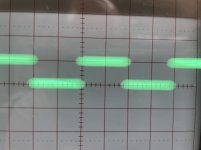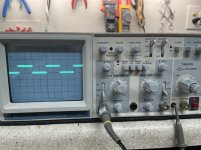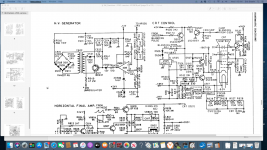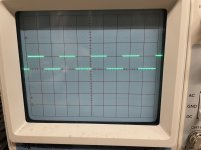I bought a used BK 2120 scope about 7 months ago, and its been pretty faithful actually up until this afternoon. I know how to use it and have been using it on average about an hour per day since purchase.
The trace line for both channels just today quadrupled in height. Focus cannot get the trace line as sharp as it was even just this morning. Nothing has changed at all afaik but then again dealing with old equipment. The scope still works otherwise but very annoying not seeing that sharp trace.
I opened it up but everything seems very clean inside.
Foreign object to me. There are no pots for focus fine-tune adjustment within either.
Anybody know how I might service this?
The trace line for both channels just today quadrupled in height. Focus cannot get the trace line as sharp as it was even just this morning. Nothing has changed at all afaik but then again dealing with old equipment. The scope still works otherwise but very annoying not seeing that sharp trace.
I opened it up but everything seems very clean inside.
Foreign object to me. There are no pots for focus fine-tune adjustment within either.
Anybody know how I might service this?
Digital TV style...get the service manual...the focus may be controlled from processor inside.
Check the power supply, and the EHT.
It can kill you, be careful around high voltages.
Check the power supply, and the EHT.
It can kill you, be careful around high voltages.
I know theres 2KV in there maybe more. Enough to fry some eggs and meters.
VR503 is the focus pot. While powered if I touch the positive meter lead to any of the legs of VR503 the trace immediately sharpens to a level I've never seen before.
I'll do some more testing tomorrow, but for now I'm thinking C511, or C512 may be out of spec.
VR503 is the focus pot. While powered if I touch the positive meter lead to any of the legs of VR503 the trace immediately sharpens to a level I've never seen before.
I'll do some more testing tomorrow, but for now I'm thinking C511, or C512 may be out of spec.
Attachments
Last edited:
My first suspect would be any of the high value resistors in the focus chain. Also do not discount the focus pot being faulty.
Why not just calculate the voltage expected across each resistor in the chain and see what you get.
Why not just calculate the voltage expected across each resistor in the chain and see what you get.
And another thought (depends on the range it has) is the astigmatism part of the circuit. Easy one to check by measuring the voltage on Q510 emitter and seeing if it looks reasonable. Probably around 90 to 100 volts.
I found R526 blown open. Easy fix! Trace is now sharper than ever. Thank you!
Attachments
Last edited:
Excellent 
And for info... resistors have voltage as well as power ratings. You should make sure that replacements are suitable. 500 volts across 1.5meg is well under 200 milliwatts so power handling is not an issue but voltage rating is. It is always stated in the data sheets.

And for info... resistors have voltage as well as power ratings. You should make sure that replacements are suitable. 500 volts across 1.5meg is well under 200 milliwatts so power handling is not an issue but voltage rating is. It is always stated in the data sheets.
Thats a good point. I paralleled two 3M resistors from my 1/2w variety pack to get the 1.5M needed. No clue on the device voltage ratings. Honestly never really thought about resistor voltage ratings as I mostly work with less than 100v devices, and IF that across any resistor even. I'll go ahead and order up a few 1M, 1.5M, & 2M at better voltage ratings.
...I paralleled two 3M resistors from my 1/2w variety pack to get the 1.5M needed. No clue on the device voltage ratings.....
There's roughly 500V on that part (and the others). That's why it says "1/2W" even though it is only 0.17W dissipation. This is one place where two 1/4W parts do not make a 1/2W part. The smaller body size won't stand as much voltage. (But you wisely used two 1/2W parts.)
It used to be that voltage rating scaled with dissipation because both go by body size. In this micro-minaturized world it may be wise to check the actual parts in hand.
And of course R526 has the same strain and R528 has more. Slight over-voltage is a long-term failure. Agree with Mooly that the others may be on a last leg.
Thanks guys. I already added to one of my carts all the needed 1/2w sizes. Mostly in 3KV rating.
If you can't find resistors rated for high enough voltage, you can always connect two or more resistors in series.
Tom
Tom
- Home
- Design & Build
- Equipment & Tools
- BK Precision 2120 gone blurry



